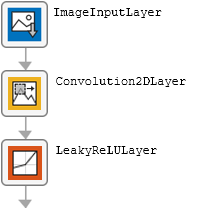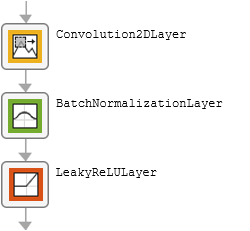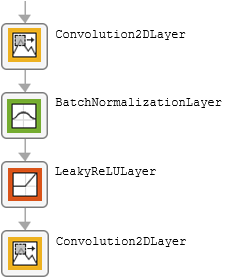patchGANDiscriminator
Description
net = patchGANDiscriminator(inputSize)inputSize.
For more information about the PatchGAN network architecture, see PatchGAN Discriminator Network.
This function requires Deep Learning Toolbox™.
net = patchGANDiscriminator(inputSize,Name=Value)
You can create a 1-by-1 PatchGAN discriminator network, called a pixel discriminator
network, by specifying the NetworkType name-value argument as
"pixel". For more information about the pixel discriminator network
architecture, see Pixel Discriminator Network.
Examples
Specify the input size of the network for a color image of size 256-by-256 pixels.
inputSize = [256 256 3];
Create the PatchGAN discriminator network with the specified input size.
net = patchGANDiscriminator(inputSize)
net =
dlnetwork with properties:
Layers: [13×1 nnet.cnn.layer.Layer]
Connections: [12×2 table]
Learnables: [16×3 table]
State: [6×3 table]
InputNames: {'input_top'}
OutputNames: {'conv2d_final'}
Initialized: 1
View summary with summary.
Display the network.
analyzeNetwork(net)
Specify the input size of the network for a color image of size 256-by-256 pixels.
inputSize = [256 256 3];
Create the pixel discriminator network with the specified input size.
net = patchGANDiscriminator(inputSize,"NetworkType","pixel")
net =
dlnetwork with properties:
Layers: [7×1 nnet.cnn.layer.Layer]
Connections: [6×2 table]
Learnables: [8×3 table]
State: [2×3 table]
InputNames: {'input_top'}
OutputNames: {'conv2d_final'}
Initialized: 1
View summary with summary.
Display the network.
analyzeNetwork(net)
Input Arguments
Network input size, specified as a 3-element vector of positive integers.
inputSize has the form [H
W
C], where H is the height,
W is the width, and C is the number of
channels. If the input to the discriminator is a channel-wise concatenated dlarray (Deep Learning Toolbox) object,
then C must be the concatenated size.
Example: [28 28 3] specifies an input size of 28-by-28 pixels for
a 3-channel image.
Name-Value Arguments
Specify optional pairs of arguments as
Name1=Value1,...,NameN=ValueN, where Name is
the argument name and Value is the corresponding value.
Name-value arguments must appear after other arguments, but the order of the
pairs does not matter.
Example: net = patchGANDiscriminator(inputSize,FilterSize=5) creates a
discriminator whose convolution layers have a filter of size 5-by-5 pixels.
Before R2021a, use commas to separate each name and value, and enclose
Name in quotes.
Example: net = patchGANDiscriminator(inputSize,"FilterSize",5) creates
a discriminator whose convolution layers have a filter of size 5-by-5 pixels.
Type of discriminator network, specified as one of these values.
"patch"– Create a PatchGAN discriminator"pixel"– Create a pixel discriminator, which is a 1-by-1 PatchGAN discriminator
Data Types: char | string
Number of downsampling operations of the network, specified as a positive integer.
The discriminator network downsamples the input by a factor of
2^NumDownsamplingBlocks. This argument is ignored when you
specify NetworkType as "pixel".
Number of filters in the first discriminator block, specified as a positive integer.
Filter size of convolution layers, specified as a positive integer or 2-element
vector of positive integers of the form [height
width]. When you specify the filter size as a scalar, the filter
has equal height and width. Typical filters have height and width between 1 and 4.
This argument has an effect only when you specify NetworkType as
"patch".
Style of padding used in the network, specified as one of these values.
PaddingValue | Description | Example |
|---|---|---|
| Numeric scalar | Pad with the specified numeric value |
|
"symmetric-include-edge" | Pad using mirrored values of the input, including the edge values |
|
"symmetric-exclude-edge" | Pad using mirrored values of the input, excluding the edge values |
|
"replicate" | Pad using repeated border elements of the input |
|
Weight initialization used in convolution layers, specified as
"glorot", "he",
"narrow-normal", or a function handle. For more information, see
Specify Custom Weight Initialization Function (Deep Learning Toolbox).
Activation function to use in the network, specified as one of these values. For more information and a list of available layers, see Activation Layers (Deep Learning Toolbox).
"relu"— Use areluLayer(Deep Learning Toolbox)"leakyRelu"— Use aleakyReluLayer(Deep Learning Toolbox) with a scale factor of 0.2"elu"— Use aneluLayer(Deep Learning Toolbox)A layer object
Activation function after the final convolution layer, specified as one of these values. For more information and a list of available layers, see Activation Layers (Deep Learning Toolbox).
"tanh"— Use atanhLayer(Deep Learning Toolbox)"sigmoid"— Use asigmoidLayer(Deep Learning Toolbox)"softmax"— Use asoftmaxLayer(Deep Learning Toolbox)"none"— Do not use a final activation layerA layer object
Normalization operation to use after each convolution, specified as one of these values. For more information and a list of available layers, see Normalization Layers (Deep Learning Toolbox).
"instance"— Use aninstanceNormalizationLayer(Deep Learning Toolbox)"batch"— Use abatchNormalizationLayer(Deep Learning Toolbox)"none"— Do not use a normalization layerA layer object
Prefix to all layer names in the network, specified as a string or character vector.
Data Types: char | string
Output Arguments
PatchGAN discriminator network, returned as a dlnetwork (Deep Learning Toolbox) object.
More About
A PatchGAN discriminator network consists of an encoder module that
downsamples the input by a factor of 2^NumDownsamplingBlocks. The
default network follows the architecture proposed by Zhu et. al. [2].
The encoder module consists of an initial block of layers that performs one downsampling
operation, NumDownsamplingBlocks–1 downsampling blocks, and a final
block.
The table describes the blocks of layers that comprise the encoder module.
| Block Type | Layers | Diagram of Default Block |
|---|---|---|
| Initial block |
|
|
| Downsampling block |
|
|
| Final block |
|
|
A pixel discriminator network consists of an initial block and final block that return an output of size [H W C]. This network does not perform downsampling. The default network follows the architecture proposed by Zhu et. al. [2].
The table describes the blocks of layers that comprise the network.
| Block Type | Layers | Diagram of Default Block |
|---|---|---|
| Initial block |
|
|
| Final block |
|
|
References
[1] Isola, Phillip, Jun-Yan Zhu, Tinghui Zhou, and Alexei A. Efros. "Image-to-Image Translation with Conditional Adversarial Networks." In 2017 IEEE Conference on Computer Vision and Pattern Recognition (CVPR), 5967–76. Honolulu, HI: IEEE, 2017. https://arxiv.org/abs/1611.07004.
[2] Zhu, Jun-Yan, Taesung Park, and Tongzhou Wang. "CycleGAN and pix2pix in PyTorch." https://github.com/junyanz/pytorch-CycleGAN-and-pix2pix.
Version History
Introduced in R2021a
MATLAB Command
You clicked a link that corresponds to this MATLAB command:
Run the command by entering it in the MATLAB Command Window. Web browsers do not support MATLAB commands.
选择网站
选择网站以获取翻译的可用内容,以及查看当地活动和优惠。根据您的位置,我们建议您选择:。
您也可以从以下列表中选择网站:
如何获得最佳网站性能
选择中国网站(中文或英文)以获得最佳网站性能。其他 MathWorks 国家/地区网站并未针对您所在位置的访问进行优化。
美洲
- América Latina (Español)
- Canada (English)
- United States (English)
欧洲
- Belgium (English)
- Denmark (English)
- Deutschland (Deutsch)
- España (Español)
- Finland (English)
- France (Français)
- Ireland (English)
- Italia (Italiano)
- Luxembourg (English)
- Netherlands (English)
- Norway (English)
- Österreich (Deutsch)
- Portugal (English)
- Sweden (English)
- Switzerland
- United Kingdom (English)


